In this guide, we will scrape Google Flights data using Python. Why? Now, people book flights via online platforms like Google Flights as it gives them much more details on searching for best prices, suited times, booking accommodations, and of course, helps them with finding the best flight deals available. Google Flights simplifies the process of comparing fares across different airlines and provides valuable insights for travelers looking to make informed decisions.
So, let’s dive into some more details on why you should scrape Google Flights, key data points you can extract from it and learn how to do it like a pro.
If you’d like to get straight into Google Flights web scraper, click here.
Table Of Contents
- Install Prerequisites
- Scrape Company Name from Google Flights
- Scrape Flight Duration from Google Flights
- Scrape Prices from Google Flights
- Scrape Departure and Arrival Dates from Google Flights
- Scrape Flight CO2 Emission from Google Flights
- Scrape Flight Stops from Google Flights
- Complete the Code
Why Scrape Google Flights?
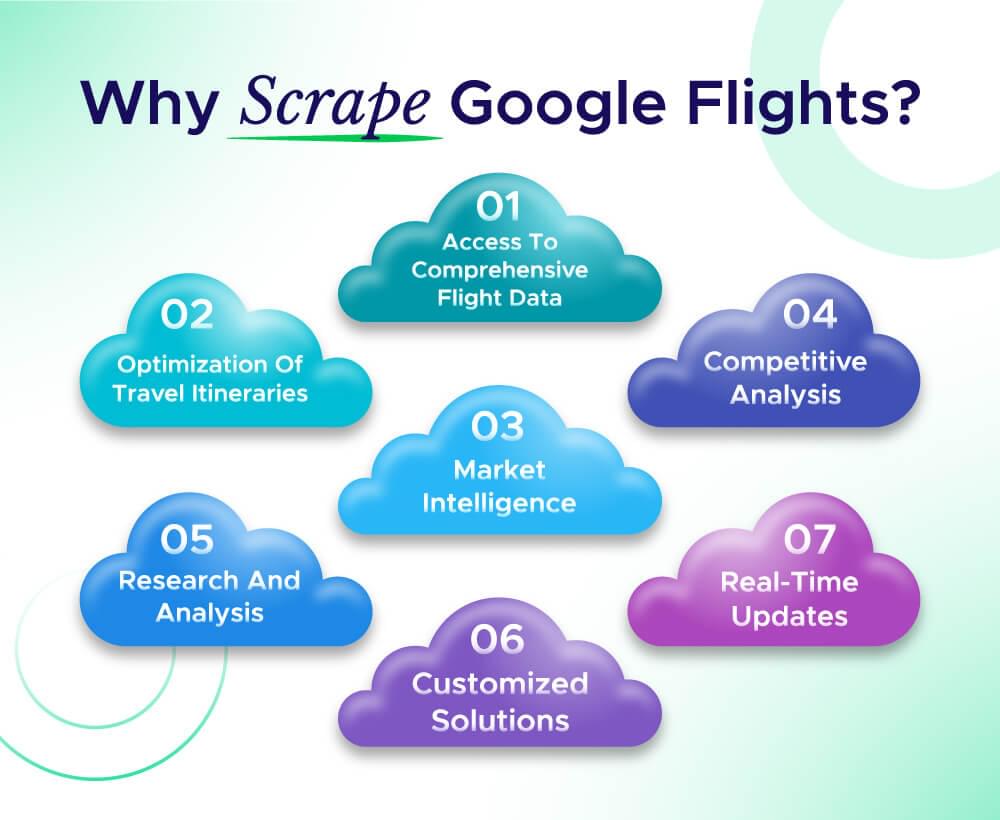
Google Flights’ scraper provides valuable insights and competitive advantages for travelers, businesses, and researchers alike. By extracting data from Google Flights, users can access information about flight options, prices, schedules, and more. This data can be used to compare fares across different airlines, analyze trends in pricing and availability, and make informed decisions when planning trips.
For travelers, scraping Google Flights can help find the best deals and optimize travel itineraries. For businesses in the travel industry, such as airlines, travel agencies, and hotel chains, scraping Google Flights can provide valuable market intelligence and competitive analysis. Researchers can also leverage scraped data from Google Flights to study travel patterns, consumer behavior, and industry trends.
Overall, scraping Google Flights offers a powerful tool for accessing and analyzing flight-related data, enabling users to make better-informed decisions and gain a competitive edge in the travel market.
Google Flights Key Data Points
When web scraping Google Flights, several key data points can be extracted to provide valuable insights for travelers and businesses:
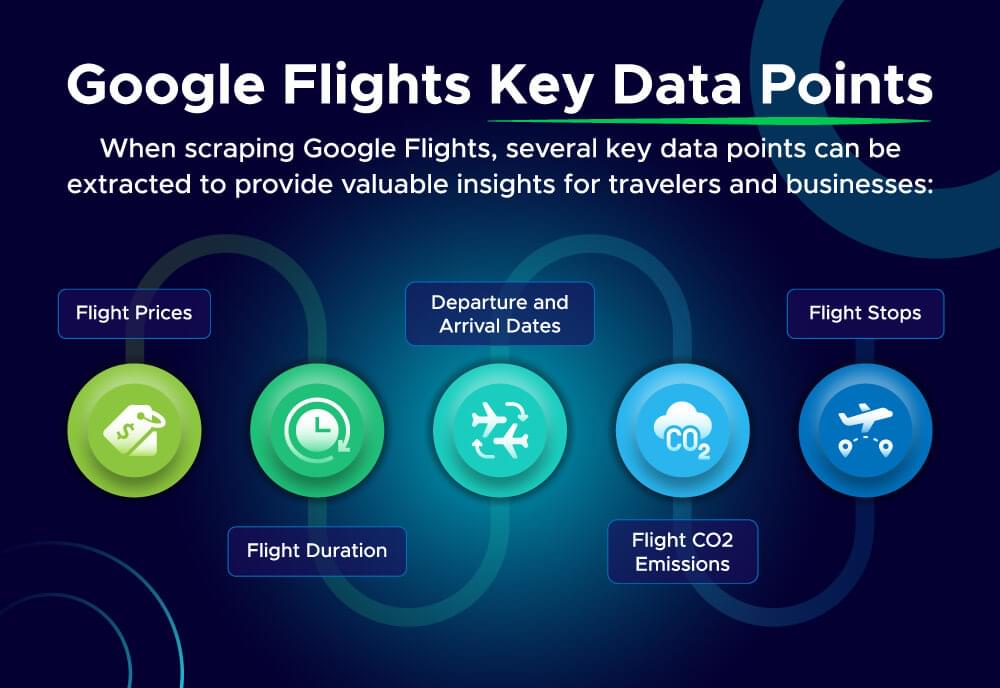
- Flight Prices: One of the most crucial data points, flight prices vary based on factors such as airline, time of booking, and destination. Scraping Google Flights allows users to monitor and compare prices across different airlines and routes.
- Flight Duration: Knowing the duration of a flight is essential for travelers planning their itineraries. Scraped data can provide insights into the length of flights between specific origins and destinations.
- Departure and Arrival Dates: Scraping Google Flights can reveal the availability of flights on specific dates, helping travelers find the most convenient departure and arrival times for their journeys.
- Flight CO2 Emissions: With increasing awareness of environmental concerns, many travelers are interested in minimizing their carbon footprint. Web Scraping Google Flights can provide data on flight CO2 emissions, allowing travelers to make more eco-friendly travel choices.
- Flight Stops: Understanding the number and locations of stops along a flight route is crucial for travelers planning their journeys. Scraped data can reveal information about layovers, connecting flights, and stopover destinations.
By extracting these key data points from Google Flights, users can make more informed decisions when booking flights, optimizing their travel experiences and maximizing cost savings. Additionally, businesses in the travel industry can use Google Flights scraper to leverage scraped data for market analysis, pricing strategies, and competitive intelligence.
How to Scrape Google Flights in Python
Let’s quickly get into the first step, which is, of course, setting up the environment to build a custom Google Flights scraper.
Install Prerequisites
Setting up the environment for scraping Google Flights involves ensuring that all necessary tools and libraries are installed and configured properly. Follow the following steps to set up the environment:
Python Installation: Before proceeding, make sure Python is installed on your system. You can check if Python is installed by opening your terminal or command prompt and entering the following command:
1 | python --version |
If Python is not installed, download and install the latest version from the official Python website.
Virtual Environment: It’s recommended to create a virtual environment to manage project dependencies and avoid conflicts with other Python projects. Navigate to your project directory in the terminal and execute the following command to create a virtual environment named “google_flights_env”:
1 | python -m venv google_flights_env |
Activate the virtual environment by running the appropriate command based on your operating system:
On Windows:
1
2google_flights_env\Scripts\activate
On macOS/Linux:
1
source google_flights_env/bin/activate
Installing Required Libraries: With the virtual environment activated, install the necessary Python libraries for web scraping. The primary libraries you’ll need are requests and BeautifulSoup4. Execute the following commands to install them:
1 | pip install requests |
Code Editor: Choose a code editor or Integrated Development Environment (IDE) for writing and running your Python code. Popular options include PyCharm, Visual Studio Code, and Jupyter Notebook. Install your preferred code editor and ensure it’s configured to work with Python.
By following these steps, you’ll have a properly configured environment for web scraping Google Flights data using Python. With the necessary tools and libraries installed, let’s head into extracting various key pieces of information from the website.
Scrape Google Flights Company Name:
To scrape the company name (airline) from Google Flights, you can use BeautifulSoup to parse the HTML and locate the element containing the airline information.
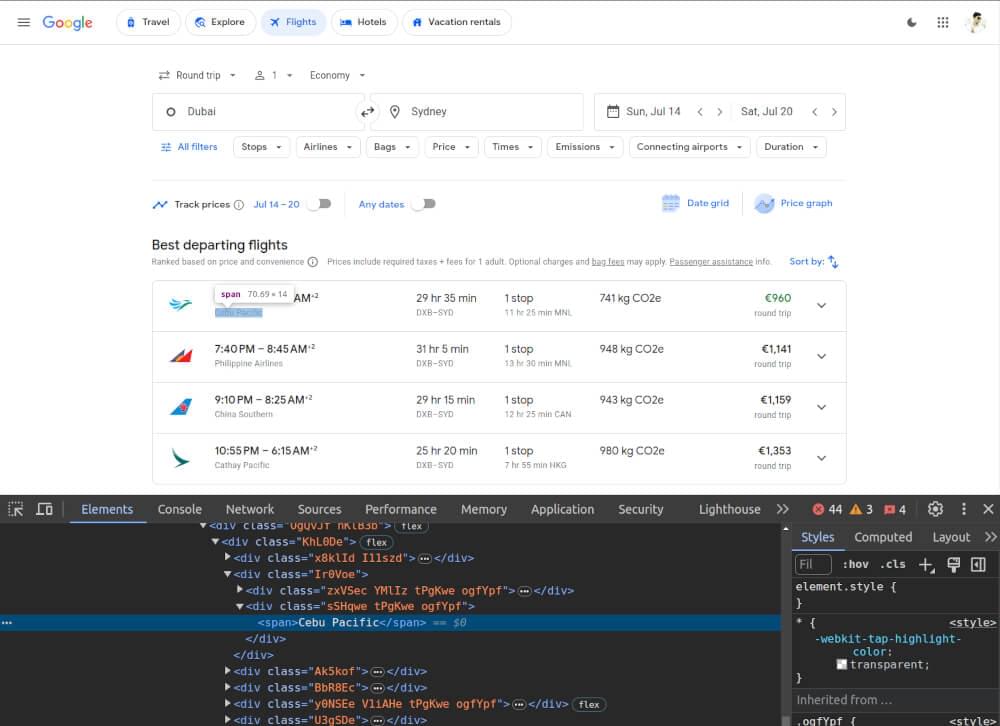
Here’s a function:
1 | def scrape_company_name(listing): |
Scrape Google Flights Flight Duration:
Extracting the flight duration involves locating the relevant HTML element that contains this information and retrieving its text content.
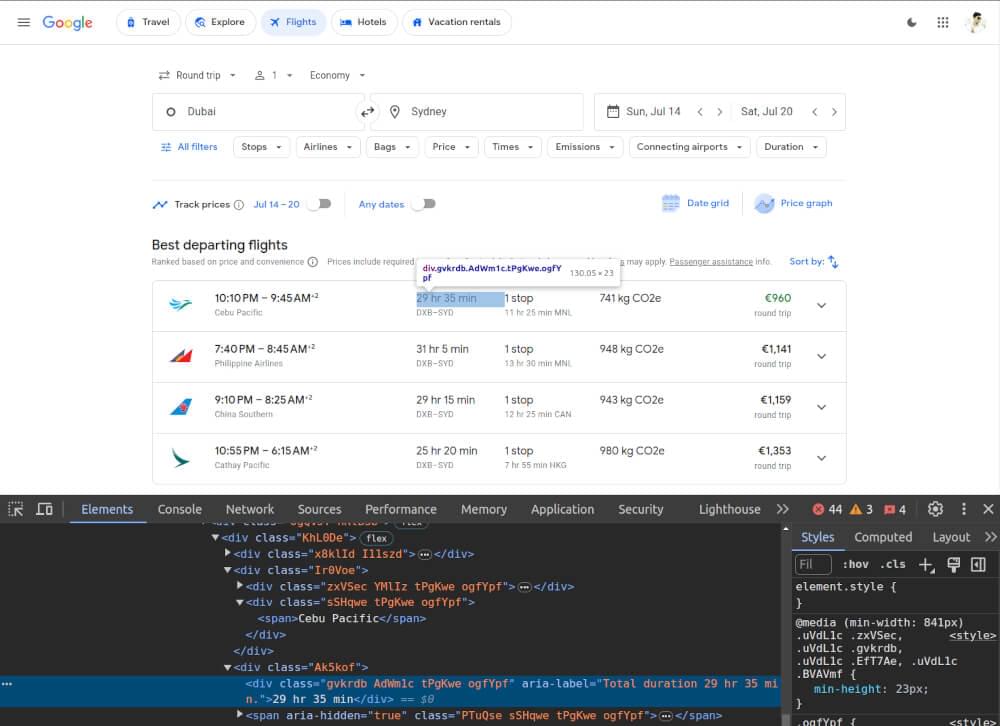
Here’s how you can do it:
1 | def scrape_flight_duration(listing): |
Scrape Google Flights Prices:
Prices on Google Flights are typically displayed prominently, making them relatively easy to scrape. You can locate the price element and extract its text content.
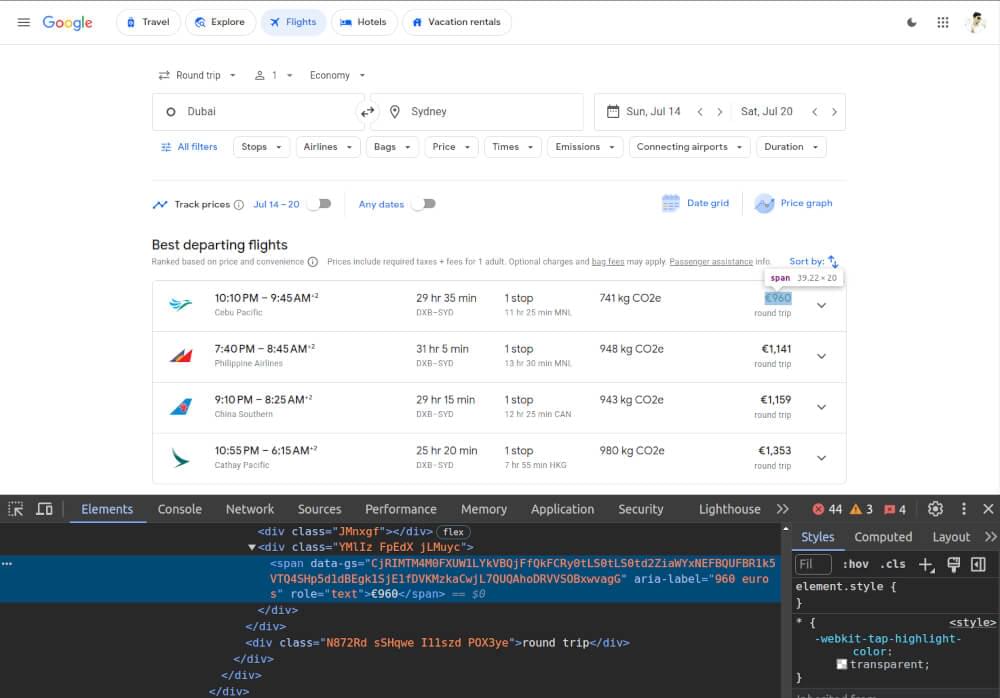
Here’s a function:
1 | def scrape_price(listing): |
Scrape Google Flights Departure and Arrival Dates:
Departure and arrival dates are essential for travelers. You can locate the elements containing this information and extract the date values.
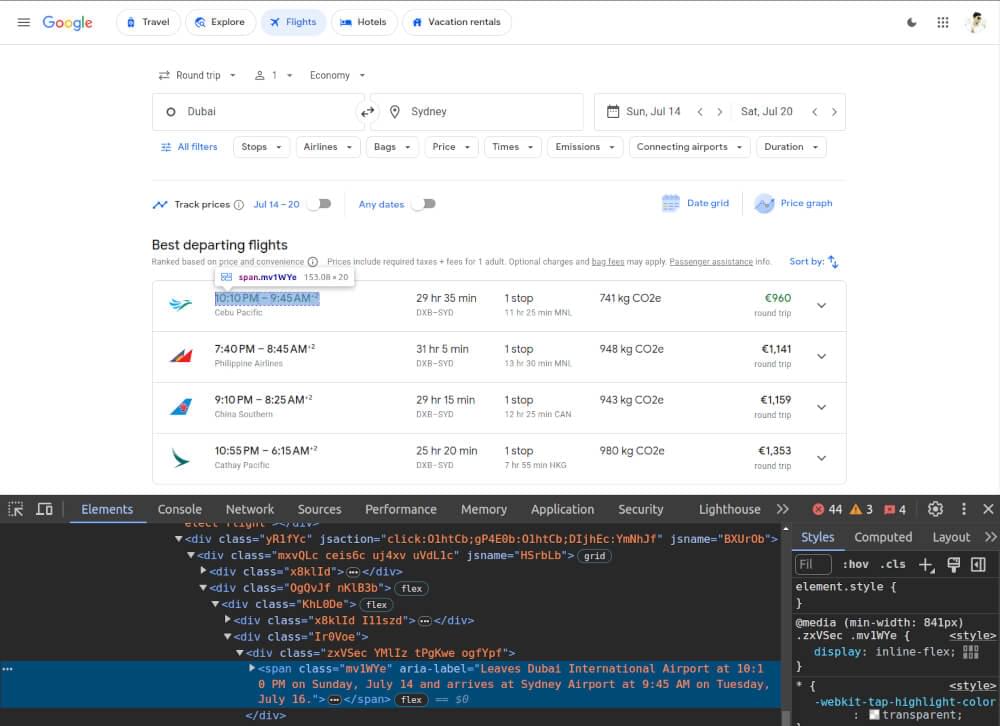
Here’s how you can do it:
1 | def scrape_departure_arrival_dates(listing): |
Scrape Google Flights CO2 Emission:
Google Flights sometimes displays information about flight CO2 emissions. You can extract this data by locating the relevant HTML element and retrieving its text content.
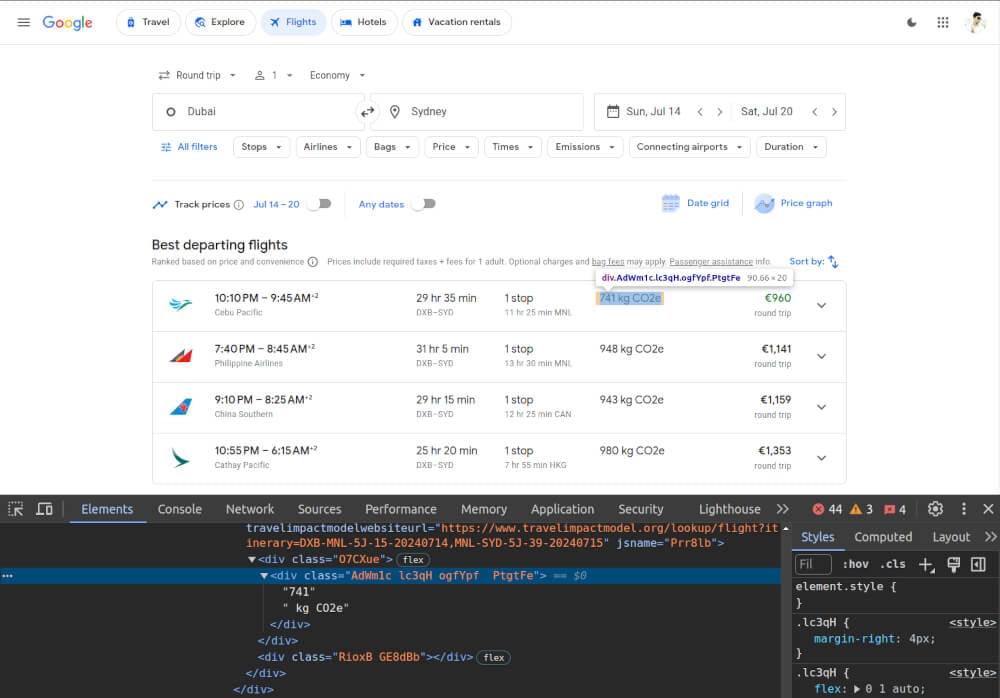
Here’s a code snippet:
1 | def scrape_co2_emission(listing): |
Scrape Google Flights Stops:
To extract information about flight stops (layovers), locate the relevant HTML element and retrieve its text content.
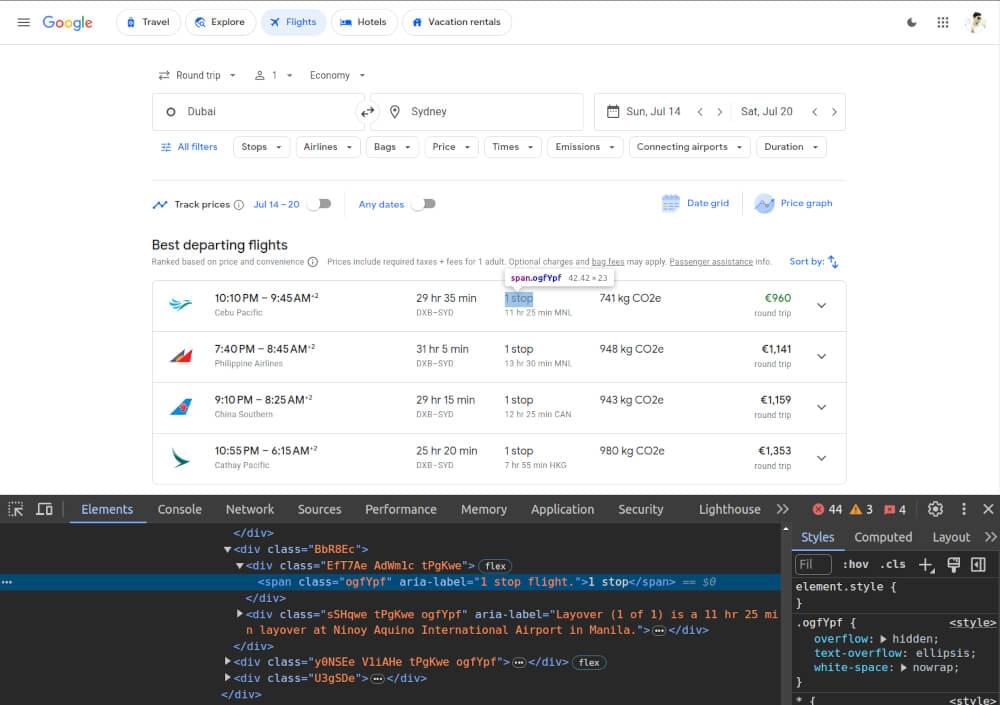
Here’s how you can do it:
1 | def scrape_flight_stops(listing): |
Complete the Code:
Below is the complete code that combines all the scraping functions mentioned above:
1 | # Import necessary libraries |
Example Output:
1 | [ |
Scalable Google Flights Web Scraping with Crawlbase
Crawlbase offers a reliable solution for handling dynamic content on Google Flights and ensures smooth data extraction at scale. By leveraging Crawlbase’s Crawling API, you can overcome challenges such as IP blocking, CAPTCHA challenges, and anti-scraping measures implemented by Google Flights.
Crawlbase provides a Python library that seamlessly integrates with your scraping workflow. You can easily replace traditional HTTP requests with Crawlbase API calls to fetch web pages. Here’s how you can use Crawlbase for scalable scraping:
Installation: Begin by installing the Crawlbase Python library using pip:
1 | pip install crawlbase |
Authentication: Obtain an access token from Crawlbase after creating an account. This token is used for authentication when making API requests.
API Usage: Replace your standard HTTP requests with Crawlbase Crawling API calls. Here’s an example of fetching a web page using Crawlbase:
1 | from crawlbase import CrawlingAPI |
Handling Dynamic Content: Crawlbase Crawling API also provide features for handling JavaScript rendering, ensuring that dynamic content on targeted webpage is fully loaded and accessible for scraping.
Scalability: Crawlbase Crawling API offers a pool of residential IP addresses, enabling you to distribute your scraping requests across multiple IPs. This helps prevent IP blocking and ensures uninterrupted scraping operations even at scale.
CAPTCHA Solving: Crawlbase Crawling API handles CAPTCHA challenges automatically, allowing your scraping process to continue seamlessly without manual intervention.
By incorporating Crawlbase into your scraping workflow, you can bypass captchas and achieve scalable and efficient data extraction from Google Flights while overcoming common challenges associated with web scraping.
Final Thoughts
Scraping data from Google Flights can provide valuable insights for travelers and businesses alike. By extracting key information such as flight prices, duration, and CO2 emissions, individuals can make informed decisions when booking flights. At the same time, businesses can utilize the data for competitive analysis and market research.
While the process of scraping Google Flights may present challenges due to dynamic content and anti-scraping measures, leveraging tools like Crawlbase can significantly simplify and streamline the scraping process. With its scalable crawling API and handling of dynamic content, Crawlbase enables efficient data extraction without the risk of IP blocking or CAPTCHA challenges.
If you’re looking to expand your web scraping capabilities, consider exploring our Google Scraper and our following guides on scraping other important websites.
📜 How to Scrape Google Finance
📜 How to Scrape Google News
📜 How to Scrape Google Scholar Results
📜 How to Scrape Google Search Results
📜 How to Scrape Google Maps
📜 How to Scrape Yahoo Finance
📜 How to Scrape Zillow
If you have any questions or feedback, our support team is always available to assist you on your web scraping journey. Happy Scraping!
Frequently Asked Questions
Q. Is scraping Google Flights legal?
Scraping Google Flights can be legal if done ethically and in compliance with the website’s terms of service. It’s essential to review and adhere to the website’s robots.txt file, which specifies whether scraping is allowed and any limitations or restrictions. Additionally, it’s crucial to avoid overloading the website’s servers with excessive requests, as this could constitute a violation of their terms of service and potentially lead to IP blocking or other measures.
Q. How do I get data from Google Flights?
Extracting data from Google Flights involves using web scraping techniques to retrieve information from the website’s HTML structure. Python libraries like BeautifulSoup and requests are commonly used for this purpose. By sending HTTP requests to the Google Flights website and parsing the HTML responses, you can extract data such as flight prices, schedules, and availability. Alternatively, you can leverage scraping tools or APIs like Crawlbase to simplify the process and handle dynamic content more efficiently.
Q. How accurate is the data on Google Flights?
The data provided on Google Flights is generally reliable and sourced directly from airlines and travel booking platforms. However, it’s essential to recognize that the accuracy of the information can vary depending on factors such as real-time updates from airlines, availability of seats, and pricing fluctuations. While Google Flights strives to provide accurate and up-to-date data, it’s always a good idea to verify the details directly with the airline or booking site before making any travel arrangements.
Q. What are the limitations of scraping Google Flights?
Scraping Google Flights presents various challenges like IP blocking, CAPTCHA challenges, and changes in website layout. Google Flights also implements anti-scraping measures, making scraping more difficult. To overcome these hurdles, developers can use techniques such as rotating proxies, managing CAPTCHA challenges, and adjusting scraping parameters. Utilizing a reliable scraping tool like Crawlbase can enhance the process, ensuring smoother and more scalable scraping.










